Architects used to rely on stacks of drawings to convince clients that a building would work. Some still do. But these days? Try showing someone a flat sketch and watch their eyes glaze over. People want motion.
They want to see the light shift in a living room, the way an office lobby feels when you step inside, or how a tower blends into the street below. That’s exactly what 3D architectural animation delivers, and it’s why the architectural industry has leaned so heavily on it.
If you’ve ever scrolled through a property developer’s website and found yourself staring at a smooth flythrough of a yet-to-be-built apartment complex, that’s the work of architectural 3D animation. It’s not decoration. It’s persuasion wrapped in pixels.
This guide unpacks the whole thing. What the process looks like, the main types of architectural animation, the tech that drives it, and the benefits of 3D animation in architecture design. And yes, we’ll talk about why professional 3D architectural animation services are in such high demand.
So, What Exactly is 3D Architectural Animation?
Strip it down to basics: 3D architectural animations are short films built from a digital 3D model of the architectural design. A model is created, materials are applied, lighting is set, and the camera starts moving. Stitch the frames together, and suddenly you’re walking through a building that doesn’t exist yet.
Unlike a still image, which freezes a single angle, animations show the whole experience. They reveal scale, rhythm, atmosphere. Want to know how morning light lands in a kitchen? Or how a long hallway actually feels? A video can show it instantly.
That’s the difference. Stills hint. Animations prove.
Why the Architectural Industry Swears By It
Designing a building isn’t just about drawings; it’s about winning hearts, investors, and approvals. That’s why 3D animation in architectural design matters. It simplifies communication. A board member who’s never read a plan can suddenly “get it” within minutes of watching.
A report suggests the 3D architectural animation market was USD 3.25 billion in 2024 and predicts it will grow to approximately USD 6.12 billion by 2033. CAGR is approximately 7.5%
For the modern architectural practice, the advantages stack up fast:
- Projects are easier to sell.
- Issues are spotted before construction.
- Developers get slick marketing content.
- Studios offering 3D animation services stand out as more credible.
That’s the reality. A single animation can save thousands in revisions, months in approvals, and possibly even rescue a pitch.
How 3D Architectural Animation Gets Made
The polished videos you see look effortless, but the process is anything but. Professional 3D architectural animation studios follow a chain of steps, each one building toward realism.
Step 1: The Brief
Every project starts with a story. Who’s the audience? What’s the tone: formal, luxurious, welcoming? The storyboard is drafted: which rooms to feature, how the camera should glide, which shots matter most.
Step 2: Modeling
Next comes the geometry. Artists construct the digital 3D model of the architectural design, walls, doors, staircases, facades. The detail here has to be right, or everything else collapses. Furniture and surroundings are often added too, to make the animation feel grounded.
Step 3: Texturing
Bare models look like plastic toys. Texturing fixes that. Wood grain on floors, stone patterns on facades, glass that reflects the environment. Every surface gets assigned a realistic material.
Step 4: Lighting
Lighting is where the model starts breathing. Exterior shots rely on daylight and shadows. Interiors lean on artificial light to set mood. Done right, the viewer forgets they’re watching a simulation.
Step 5: Animation
Now it moves. The camera sweeps across spaces, lingers on key features, maybe circles around the building. Sometimes you’ll see small life touches, doors opening, people moving, just enough to feel real.
Step 6: Rendering
The heavy lifting. Each frame is calculated, pixel by pixel, accounting for reflections, shadows, textures. This is the most resource-hungry part. Many studios send it to powerful render farms to cut waiting times.
Step 7: Post-Production
Raw renders look flat. Editors tweak brightness, adjust contrast, add sound or captions. A technical output becomes a polished story fit for presentations.
Types of Architectural Animation
Not every project needs the same approach. Common styles include:
- Exterior flythroughs showing facades and landscaping.
- Interior walkthroughs taking viewers room to room.
- Aerial sweeps, simulated drone footage over whole complexes.
- Concept previews for early design discussions.
- VR animations that let viewers control the walk.
Each type plays a different role in communication, approval, or marketing.
The Advantages of 3D Architectural Visualization
Now to the big question, why bother? Why not just stick with static renders?
The advantages of 3D architectural visualization speak for themselves:
- Clients see designs as experiences, not puzzles.
- Problems pop up earlier, saving both money and frustration.
- Marketing campaigns feel more polished with video.
- Updating visuals is far easier than redrawing.
- Studios offering 3D architectural animation services gain trust and authority fast.
For many firms, the choice isn’t optional anymore. If you want to compete in today’s architectural industry, this is the new standard.
Why Hire a 3D Architectural Animation Studio Instead of DIY
The software is out there. Tutorials are out there. So why not just have someone in-house whip up animations?
Because it shows. The difference between amateur work and professional work is stark. Lighting looks fake, camera paths feel stiff, textures repeat unnaturally. It’s like the difference between a phone video and a studio-produced commercial.
A dedicated 3D architectural animation studio brings more than equipment. They bring taste, training, and the ability to tell a story through space. Their videos don’t just explain a design, they sell it. And that’s why so many architects and developers outsource to specialized teams.
Going Deeper into 3D Architectural Animation
Types of Architectural Animation You’ll Come Across
3D architectural animation is not one straight path. It bends depending on the purpose. A project made for investors looks very different from one meant to help a family see their new home. Here are the main styles used in modern architectural practice.
Exterior Animations
These are the crowd-pleasers. Exterior animations highlight the building’s face, the play of sunlight on glass, or the way greenery softens hard edges. A digital 3D model of the architectural design lets clients preview how the structure fits into its surroundings.
Interior Animations
When the focus is on atmosphere, interior animations take charge. They give a sense of how rooms connect, how light changes from morning to night, and how furniture settles into a space. Developers lean on these for off-plan sales.
Walkthroughs and Flythroughs
A walkthrough lets you step inside the space virtually. The camera follows a natural path through rooms and hallways. A flythrough pulls back to show the bigger picture, often starting with a sweeping aerial view. Both formats are staples in architectural 3D animation.
Concept Animations
Sometimes a project is still raw. Concept animations sell the vision before the details are locked in. These animations focus on massing, flow, and the main idea rather than polished finishes.
Tools Behind Specialized Architectural Visualization
Without the right software, architectural designs stay flat. The following tools are the backbone of most 3D animation services today.
Autodesk 3ds Max
A long-time favorite in the architectural industry. Known for its precision, its integration with Arnold for rendering, and its wide format support. Most established 3D architectural animation studios keep it in their pipeline.
Blender
Blender has grown far beyond being “the free tool.” It’s robust, versatile, and ideal for firms that want professional output without heavy costs. Its community-driven updates make it a strong contender for architectural 3D animation.
SketchUp Pro
Easy to pick up, SketchUp Pro is often the first tool architects learn. With plugins like V-Ray, it shifts from quick sketches into fully fledged architectural animations. Importing Revit files into SketchUp also keeps things efficient.
Cinema 4D
For teams who value motion design along with architectural animation, Cinema 4D is a solid choice. Its MoGraph tools, coupled with clean modeling, make it great for both facades and interiors.
Unreal Engine
Originally built for games, Unreal Engine has turned into a powerhouse for architectural visualization. Its real-time rendering creates immersive walkthroughs that look sharp and respond instantly.
Benefits of 3D Animation in Architecture Design
For architects and firms, the benefits of 3D animation in architecture design go beyond client presentations.
- Quick Decisions: Clients move forward faster when they understand the design.
- Reduced Costs: Problems spotted early save money later.
- Reputation: Offering 3D architectural animation services sets firms apart.
- Engagement: Animations hold attention longer than drawings or photos.
Why Many Teams Choose a 3D Architectural Animation Studio
There’s skill in creating architectural designs. There’s a different skill in turning those designs into moving, realistic visuals. A 3D architectural animation studio blends both.
They know when to go for cinematic detail and when to keep things lean for efficiency. They adjust for the project goal , selling to clients, presenting to city boards, or helping engineers see technical details. That flexibility is what makes professional 3D animation services valuable.
Frequently Asked Questions
How is an animation different from a still render?
A still captures one angle. Animation shows movement, scale, and light in real time.
Do all projects need 3D animation?
No. Smaller residential projects may not justify it. Large or commercial projects usually gain the most value.
Which architectural rendering software should I choose?
It depends on the project. 3ds Max and Blender are popular. SketchUp Pro is easy to learn. Cinema 4D is flexible. Unreal Engine offers real-time results.
How long does creating a 3D animation take?
Simple walkthroughs may be ready in days. More complex projects with detail-heavy models take weeks.
Are 3D architectural animation services expensive?
The cost varies. But compared to fixing mistakes during construction, animation is often the cheaper route.
Final Words
Flat plans give outlines. 3D architectural animation makes those plans real. For firms aiming to impress clients, avoid costly mistakes, and stand out in the architectural industry, it has become essential.
Prolific Studio, one of the best animation studios in Houston, specializes in 3D animation in architectural design. With the right team and tools, your designs don’t just stay on paper; they become moving, engaging experiences that win trust and close deals.
Related Articles:










